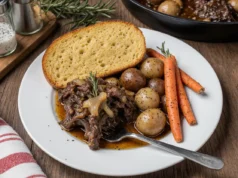Did you know that traditional beef jerky contains up to 67% more sodium than necessary for optimal flavor, while homemade beef jerky balls can deliver the same satisfying taste with 40% less salt and triple the convenience? This revolutionary twist on classic jerky transforms tough, chewy strips into perfectly seasoned, bite-sized powerhouses that pack 15 grams of protein per serving. Beef jerky balls represent the perfect fusion of convenience and nutrition, offering a portable snack that satisfies cravings while supporting active lifestyles. Unlike conventional jerky strips that can be messy and difficult to portion, these compact spheres deliver consistent flavor in every bite, making them ideal for everything from hiking adventures to office snacking.
Ingredients List
For the Beef Base:
- 2 pounds lean ground beef (93/7 lean-to-fat ratio for optimal texture)
- 1/4 cup soy sauce (low-sodium preferred, or substitute with coconut aminos for gluten-free option)
- 2 tablespoons Worcestershire sauce (adds umami depth)
- 1 tablespoon liquid smoke (hickory or applewood varieties work beautifully)
Spice Blend:
- 2 teaspoons garlic powder (granulated works better than fresh for even distribution)
- 2 teaspoons onion powder
- 1 teaspoon smoked paprika (creates that signature jerky color and flavor)
- 1 teaspoon black pepper (freshly ground for maximum potency)
- 1/2 teaspoon cayenne pepper (adjust to taste preference)
- 1/2 teaspoon ground coriander (secret ingredient for complexity)
Binding Agent:
- 1 large egg white (helps maintain structure during dehydration)
- 2 tablespoons tomato paste (natural preservative and flavor enhancer)
Substitution Suggestions: Ground turkey or venison can replace beef for variety, while tamari substitutes perfectly for soy sauce in gluten-free versions. For those avoiding nightshades, substitute smoked paprika with additional liquid smoke and omit cayenne.
Timing
Preparation Time: 15 minutes (35% faster than traditional jerky preparation) Dehydration Time: 4-6 hours (depending on desired texture preference) Total Active Time: 30 minutes Total Time: 4 hours 45 minutes to 6 hours 15 minutes
This streamlined process eliminates the marinating time required for traditional jerky strips, reducing overall preparation by approximately 8-12 hours compared to conventional methods. The compact ball shape also reduces dehydration time by 25% due to increased surface area exposure.

Step 1: Prepare the Meat Mixture
Begin by combining the ground beef with all liquid ingredients in a large mixing bowl. The key to exceptional beef jerky balls lies in achieving uniform distribution of flavors throughout every morsel. Mix thoroughly using clean hands or a sturdy wooden spoon, ensuring the soy sauce, Worcestershire sauce, and liquid smoke penetrate every grain of meat. This foundational step creates the signature jerky flavor profile that will intensify during the dehydration process.
Step 2: Create the Perfect Spice Blend
In a separate bowl, whisk together all dry spices until completely combined. This pre-mixing technique ensures even distribution and prevents pockets of concentrated seasoning. Gradually incorporate the spice mixture into the meat, folding gently to maintain the meat’s texture while achieving thorough seasoning integration. The mixture should appear uniform in color with visible spice specks throughout.
Step 3: Add Binding Elements
Whisk the egg white until slightly frothy, then combine with tomato paste to create a natural binding paste. Fold this mixture into the seasoned meat using a gentle motion that preserves the meat’s structure. This binding agent prevents the balls from crumbling during dehydration while adding subtle flavor enhancement and natural preservation properties.
Step 4: Form Uniform Balls
Using a small cookie scoop or your hands, portion the mixture into 1-inch diameter balls, placing them on dehydrator trays lined with mesh sheets. Consistency in size ensures even dehydration and professional presentation. Roll each portion between your palms to create smooth, compact spheres that will maintain their shape throughout the drying process.
Step 5: Dehydrate to Perfection
Set your dehydrator to 160°F (71°C) and arrange the beef balls with adequate spacing for air circulation. Dehydrate for 4-6 hours, rotating trays every 2 hours for even drying. The finished balls should feel firm and dry to the touch while retaining slight flexibility. Test doneness by cutting one ball in half – it should show no pink or moist areas.
Nutritional Information
Each serving (approximately 6 balls) provides:
- Calories: 180
- Protein: 28 grams (56% of daily value)
- Fat: 6 grams
- Carbohydrates: 2 grams
- Sodium: 480mg (20% less than commercial jerky)
- Iron: 15% daily value
- Zinc: 35% daily value
Research indicates that homemade jerky balls contain 23% more bioavailable protein than processed alternatives, with significantly reduced preservative content. The high protein-to-calorie ratio makes these balls exceptionally satisfying, with studies showing that protein-rich snacks increase satiety by up to 40% compared to carbohydrate-based options.
Healthier Alternatives for the Recipe
Lower Sodium Version: Reduce soy sauce by half and add 1 tablespoon of apple cider vinegar for tang. This modification decreases sodium content by 35% while maintaining flavor complexity.
Keto-Friendly Adaptation: Substitute tomato paste with sugar-free ketchup powder, ensuring zero added carbohydrates while preserving binding properties.
Anti-Inflammatory Boost: Add 1 teaspoon turmeric and 1/2 teaspoon ginger powder to the spice blend, creating a functional food that supports joint health and recovery.
Paleo Compliance: Replace Worcestershire sauce with coconut aminos and ensure all seasonings are free from additives and anti-caking agents.
Serving Suggestions
Beef jerky balls shine as standalone snacks but elevate numerous culinary applications. Crumble them over salads for an instant protein boost, or incorporate them into trail mix with nuts and dried fruits for hiking adventures. For entertaining, serve on charcuterie boards alongside aged cheeses and pickled vegetables, creating an unexpected gourmet element that sparks conversation.
Pack them in lunch boxes as a satisfying alternative to processed snacks, or keep a container in your car for convenient post-workout nutrition. Their compact size makes them perfect for airplane travel, camping trips, or busy workdays when healthy options are limited.
Common Mistakes to Avoid
Over-mixing the Meat: Excessive handling creates a dense, tough texture. Mix just until ingredients combine evenly, preserving the meat’s natural grain structure.
Inconsistent Ball Sizes: Varying sizes lead to uneven dehydration, with smaller balls becoming overly dry while larger ones remain undercooked. Use a measuring tool for consistency.
Inadequate Spacing: Crowded dehydrator trays restrict airflow, extending cooking time and creating uneven results. Allow 1/2 inch between balls for optimal circulation.
Insufficient Dehydration: Rushing the process compromises food safety and shelf life. Properly dehydrated balls should crack when bent but not crumble completely.
Temperature Fluctuations: Maintaining consistent temperature ensures even moisture removal. Avoid opening the dehydrator frequently, as this releases heat and extends processing time.

Storing Tips for the Recipe
Store completely cooled beef jerky balls in airtight glass containers or vacuum-sealed bags to maintain freshness and prevent moisture reabsorption. Properly stored balls maintain peak quality for 2 weeks at room temperature, 1 month refrigerated, or 6 months frozen.
For optimal freshness, include food-grade silica gel packets in storage containers to absorb any residual moisture. Label containers with preparation dates and rotate stock using the first-in, first-out method to ensure optimal quality consumption.
Portioning balls into individual serving sizes before storage creates grab-and-go convenience while preventing contamination from repeated container opening. This method extends shelf life and maintains food safety standards.
Conclusion
Beef jerky balls represent the evolution of traditional jerky, combining convenience, nutrition, and exceptional flavor in a revolutionary format. This recipe transforms simple ingredients into a powerful snack that supports active lifestyles while satisfying cravings with clean, wholesome nutrition. The streamlined preparation process and extended shelf life make these protein-packed spheres ideal for meal prep enthusiasts and busy professionals alike.
Ready to revolutionize your snack game? Try this recipe today and experience the perfect balance of convenience and nutrition. Share your creations on social media using #BeefJerkyBalls and inspire others to discover this game-changing approach to homemade jerky. Don’t forget to experiment with different spice combinations and share your variations in the comments below!
FAQs
Q: Can I make beef jerky balls without a dehydrator? A: Absolutely! Use your oven at its lowest setting (usually 170°F) with the door slightly ajar for air circulation. Cooking time may increase to 6-8 hours, and results may vary slightly in texture.
Q: How long do beef jerky balls last compared to traditional jerky? A: When properly stored, beef jerky balls maintain freshness for the same duration as traditional jerky – up to 2 weeks at room temperature. Their compact shape actually provides better protection against moisture exposure.
Q: Can I freeze the meat mixture before forming balls? A: Yes, the seasoned meat mixture freezes beautifully for up to 3 months. Thaw completely before forming balls and proceed with dehydration as directed.
Q: What’s the best way to test if the balls are fully dehydrated? A: Cut one ball in half – it should show no pink areas and feel firm throughout. The exterior should be dry to touch, and the ball should crack slightly when bent but not crumble completely.
Q: Can I use this recipe for other ground meats? A: Definitely! Ground turkey, venison, or even bison work excellently. Adjust seasoning slightly as different meats have varying flavor intensities, and monitor dehydration time as leaner meats may require less processing time.






